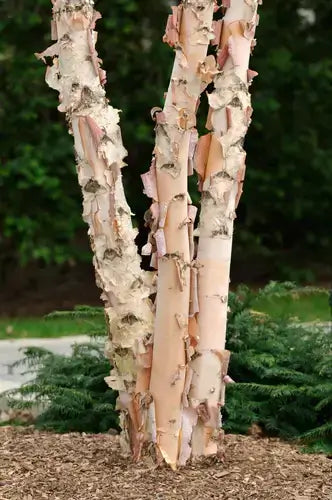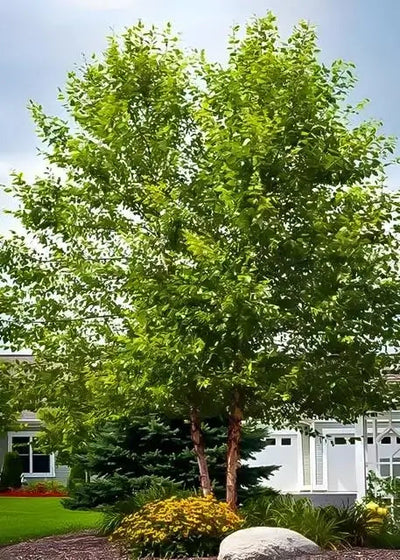What Is A River Birch Tree?
River Birch trees, scientifically known as Betula nigra, are hardwood trees that are known for their peeling bark and tall, elegant appearance. Originating in the eastern United States, they are often found in wet soil conditions, which makes them ideal for landscaping around water or in areas with moist soil. The River birch trees can adapt to different climates and soils and have a moderate growth speed.
The name comes from the fact that it was often found by rivers, streams, and ponds. Today, these trees are planted all over the country because they are easy to grow and maintain.
River birch grows to 40 to 70 inches tall and 105 feet (32 meters) wide. It has a thin gray bark and greenish shoots on small branches. The branchlets have a distinctive appressed bud. The leaves are diamond-shaped, with a glossy green appearance in summer that turns to a vibrant yellow in the fall, providing seasonal interest.
River birches also serve an important ecological role. Their ability to stabilize riverbanks and improve water quality by filtering pollutants makes them an environmentally beneficial choice for landscaping projects.
Where Do You Grow A River Birch Tree?
Choosing the Right Location
River birch trees are quite flexible with the soil pH but are slightly acidic to neutral soil (pH 5.0 to 6.5). They prefer moist, well-drained, nutrient-rich soil. To ensure your tree's health, consider performing a soil test before planting and adjusting the soil based on the results.
Sunlight and Spacing
River birch trees love full sun to partial shade. To promote growth and a healthy canopy, aim for at least 6 hours of direct sunlight each day. When planting multiple trees, space them at least 20-30 feet apart for adequate air circulation and root spread. This spacing helps prevent the spread of diseases and reduces competition for nutrients and water.
Climate Considerations
River birches are hardy in USDA zones 4 through 9, making them suitable for various climates. They are exceptionally tolerant of heat and humidity, which makes them a good choice for southern gardens where other birches might struggle. However, they are less tolerant of drought and will require additional watering during prolonged dry spells, especially in hotter climates. Apply about 1 inch of water weekly during the growing season (March through October).
When Do You Plant a River Birch Tree: A Step-by-Step Guide
The best time to plant River birch trees is during the dormant season, from late fall to early spring. Planting during this time reduces transplant shock and allows the tree to establish roots in its new location before the stress of the growing season.
- Dig a hole twice as wide as the root ball and just as deep. If necessary, mix the soil with compost to improve drainage and nutrient content.
- Remove the tree from its container and gently loosen any circling roots. Place the tree in the hole, ensuring that the top of the root ball is leveled with the surrounding soil.
- Fill the hole with the prepared soil, gently tamping down to remove air pockets.
- Water the tree deeply to settle the soil around the roots and hydrate the tree.
- Apply a 2-3 inch layer of organic mulch around the tree's base, extending to the drip line. Keep the mulch a few inches away from the trunk to prevent rot.
Water your river birch deeply once a week for the first year, allowing the water to penetrate several inches into the soil. This deep watering encourages the roots to grow deeper, which helps the tree become more drought-resistant in the future. During hot, dry periods, you may need to water more frequently.
Pruning the River Birch Tree
Pruning is essential for removing dead or diseased branches, shaping the tree, and promoting healthy growth. The best time to prune river birch is late fall to early winter when the tree is dormant. Focus on removing any branches that are rubbing together, broken, or diseased. Also, thin out the canopy to allow light and air to penetrate, which helps reduce the risk of disease. Use sharp pruning tools to make clean cuts close to the trunk or main branch without leaving stubs.
Pest and Disease Management for River Birches
River birches are relatively resistant to pests and diseases but can be susceptible to birch borers and leaf miners. Monitor your tree regularly for signs of infestation, such as discolored leaves, wilting, or holes in the bark. If you detect pests, consult a local extension service or professional arborist for the most effective treatment options.
Diseases like leaf spot and canker can also affect river birches. These are often preventable by ensuring proper planting conditions and care. To prevent the spread of disease symptoms, remove and destroy affected leaves or branches. Fungicides may be necessary for severe cases, but proper diagnosis and treatment recommendations should be sought from a professional.
Propagation Methods
Seed Propagation
River birch trees can be propagated from seeds, although this method requires patience and time. The tiny seeds need to be collected in late spring or early summer when the catkins (seed clusters) turn brown and release the seeds. Here’s how to propagate river birch from seeds:
- Collect and Prepare the Seeds: Gather catkins and allow them to dry, releasing the seeds. Because river birch seeds are light and can be easily blown away by the wind, it's best to do this in a controlled environment.
- Stratification: River birch seeds typically require a period of cold stratification to break dormancy. This involves mixing the seeds with moist sand and storing them in a refrigerator for about 4-6 weeks.
- Sowing: Sow the stratified seeds on the surface of a well-draining seed starting mix and lightly cover with soil. Keep the soil moist but not waterlogged.
- Germination: Place the seed trays in a warm, bright area (but not in direct sunlight). Germination can take several weeks, so patience is key.
- Transplanting: Once the seedlings have developed their first set of true leaves and are large enough to handle, they can be transplanted into individual pots. Harden off the seedlings before planting them in their permanent location outdoors.
Clonal Propagation Through Cuttings
Propagating river birch through cuttings is challenging and often has a lower success rate than seed propagation, but it's worth attempting if you wish to clone a specific tree.
Here’s a brief guide on how to do it:
- Cutting Selection: Select healthy, young branches from the current year's growth in late spring to early summer. Cuttings should be about 6-8 inches long and have several leaf nodes.
- Preparation: Remove the leaves from the lower half of the cutting and dip the cut end into rooting hormone powder to encourage root development.
- Planting: Plant the cuttings in pots filled with a mix of peat and perlite or sand, ensuring at least two nodes are buried in the soil. Keep the soil moist and cover the pot with a plastic bag to maintain high humidity.
- Rooting: Place the pots in a bright, warm area without direct sunlight. Rooting can take several weeks to a few months. Once rooted, the new plants can be gradually acclimated to outdoor conditions and transplanted.
Growing River birch trees can be a rewarding experience, offering both aesthetic and environmental benefits. By choosing the right location and providing proper care and maintenance, you can ensure the health and longevity of your trees. Whether you're drawn to their distinctive bark, vibrant foliage, or ecological value, river birches make a beautiful addition to any landscape.
Shop Our River Birch Trees
Visit our online shop for a wide selection of plants and trees, or come say hi at our store location in Tennessee!
We offer fast shipping nationwide, so you can transform your garden today!
If you have any questions about River birch trees or any other plant needs, don’t hesitate to contact us at customerservice@tennesseewholesalenursery.com.

